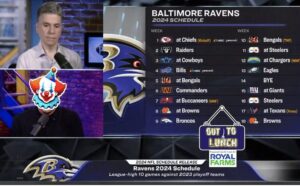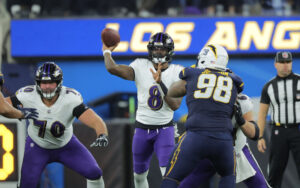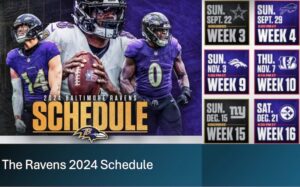

By Brian McFarland
@ravenssalarycap
Accrued Season – A player earns an Accrued Season if he is on full pay status on the team’s 53-man roster, Injured Reserve (IR), or Physically Unable to Perform (PUP) (except if the injury is non-football related) for 6 or more games in any one season.
Compensatory Draft Picks – Compensatory Draft Picks are awarded to teams who have suffered a net loss of Unrestricted Free Agents (UFAs). On occasion, a team that has lost and gain the same amount of UFAs will receive a 7th round Comp Pick, but only if the quality of UFAs lost greatly outweighs the quality of UFAs signed.
Only Unrestricted Free Agents (UFAs) – i.e. players whose contracts have expired – are considered for Comp Pick purposes. Players released by their prior teams – often referred to as Street Free Agents – do not count when determining Comp Picks.
Comp Picks are awarded at the ends of rounds 3 through 7. The formula for determining the value of those picks is somewhat of a mystery as it’s never been published, but it appears that the main criteria is the average yearly salary of the contract the UFA signed with his new team. That sets the round in which the Comp Pick is initially awarded. From there, the pick can go up or down a round based on performance, measured by post season awards or lack of playing time (including games missed due to injury).
The total number of Comp Picks – 32 – is set out in the NFL’s Collective Bargaining Agreement, which essentially adds an 8th round to the draft via Comp Picks. If there are less than 32 Comp Picks awarded under the formula, then additional draft picks are awarded at the end of the 7th round based on the draft order until 32 Comp Picks are awarded.
Exclusive Rights Free Agent (ERFA) – A player not under contract, but who has less than 3 accrued seasons. The team must tender the player with an Exclusive Rights Free Agent (ERFA) tender offer (usually the applicable minimum salary based on service time) in order to retain its rights over the player. Other teams have no ability to try and sign the player once tendered.
Franchise Player (FP) – A team may designate one Unrestricted Free Agent (UFA) per year as its Franchise Player.
There are two types of Franchise Tags, the “exclusive” and “non exclusive” tag, which determines the amount of the Franchise tender. The Franchise tender is a one-year contract that becomes guaranteed once the player signs the tender.
The tender for the “exclusive” Franchise Tag is the average of Salary Cap numbers of the top 5 players at the player’s position for that year. With the “exclusive” Tag, the player does not have the right to negotiate with other teams.
The tender for the “non-exclusive” Franchise Tag is essentially the average of percentage of the franchise tag versus the Salary Cap over the prior five (5) years for players at that position. That average percentage is then applied to the present year’s Salary Cap. With the “non-exclusive” Tag, players can negotiate offer sheets with other teams. If the player signs an offer sheet with another team, the original team has the right to match the contract. If they choose not to do so, they then receive compensation of two 1st round picks from the team that signed the franchised player.
Once franchised, the team has until July 15th to sign its franchised player to a long term deal. If they fail to do so, the player must play that year under the one-year franchise tender and cannot be signed to a contract extension until after the season has been completed.
Game Day Active Roster – Each week, every team must designate its 47 –man game day active roster. Teams can have an extra, or 48th active player, if 8 offensive lineman are amongst the 48. The 5-6 players who are inactive aren’t allowed to dress for the game and cannot play that week.
The 2020 CBA brought a new wrinkle to game day rosters by allowing teams to elevate two (2) players per week from the Practice Squad (PS) to the active game day roster. The players are then immediately returned to the Practice Squad (PS) the day after the game. Known as a Standard Elevation, players are only allowed to be elevated twice during the season without being added to the 53-man roster. The player can be elevated a third time, but is then subject to Waivers and cannot return to the Practice Squad (PS) unless he clears Waivers.
Injured Reserve (IR) – Once a player is placed on Injured Reserve (IR), the player is, with one exception, done for the season and can not practice with the team until after the completion of the season. A player on Injured Reserve (IR) does not count against any roster limit, but does count against the team’s Salary Cap.
A player can be released from Injured Reserve (IR) once he has passed his physical and has been deemed to be recovered from his injury or if the player and team agree to an Injury Settlement. The player is then free to sign elsewhere and can participate in games for the new team.
IR-DTR (Injured Reserve – Designated To Return): In 2012, the NFL and NFLPA agreed to a new IR rule that allows a team to designated 1 player for an in-season IR spot which allows that player to return later in the season. The player, must however, not be placed on IR until after the cutdown day, meaning that generally, the player must be included on the team’s initial 53-man roster before being placed on IR two day later. In 2016, the NFL and NFLPA further agreed to allow teams to not have to designate a particular player, but could “activate” any one player from IR to return to the 53-man active roster. In 2017, the rule was changed again and now teams can “activate” two players from IR. The player must be on IR for at least 6 weeks, during which he cannot practice, and must sit out a minimum of 8 weeks before being added to the 53-man active roster. At any point after 6 weeks, the player can be designated to return, which opens a 21-day window during which the player can practice before being added to the 53-man roster. If the player gets hurt during that time or isn’t ready once the 21-days is up, the player will remain on IR and the team has used up 1 or its 2 DTR designations.
Injury Settlement – In the NFL, an injured player cannot be released. Often a team and player will reach an Injury Settlement in lieu of putting, or keeping, the player on IR for the rest of the season. Once an Injury Settlement is reached, the player is released. This is done when the player has a chance to recover from injury and play again in that season. However, if the player is still under contract for future seasons and the team wants to retain the player’s rights for the future, the team will not agree to an Injury Settlement and instead decide to continue to carry the player on Injured Reserve (IR).
An Injury Settlement is usually based on the amount of time that the team and player agree the player will be unable to play. So, for example, if the player is only expected to miss the first month of the season, the team and player will usually agree to a settlement of 4/17ths of the player’s scheduled base salary. The team then receives a Salary Cap credit of 13/17th of that salary. An Injury Settlement is attractive to both the team and player because it allows the team to create additional Salary Cap space and allows the player an opportunity to catch on with another team and not have to sit out the entire season on IR.
If a player is released with an Injury Settlement, he can not be re-signed by that team until after the term of the Injury Settlement (the number of weeks used to calculate the Injury Settlement), plus three (3) additional weeks (in 2016, this was changed from 6 weeks to 3 weeks).
Injury Waivers – In the NFL, an injured player cannot be released. From the beginning of the league year in March until the final cut down date, Non-Vested Veterans (players with less than 4 years of service time) must pass through Injury Waivers (officially designated as “Waived-Injured”) before being place in Injured Reserve (IR). Vested Veterans (those with 4+ years of service time) do not have to pass through Injury Waivers and can be placed directly on Injured Reserve (IR).
If the player clears Injury Waivers, then the team has the option of either placing the player on Injured Reserve (IR) or working out an Injury Settlement with the player, thereby allowing the team to release the player. An Injury Settlement must occur within 5 days of being placed on Injured Reserve (IR). Otherwise, the player must remain on Injured Reserve (IR) for the remainder of the season or until the player is healthy enough to pass a physical, at which time the player can be released.
For a more thorough explanation the Waiver Rules, go to THIS ARTICLE.
League Year – The League Year runs from early March until early March of the following year. The League Year begins at 4:00 p.m. ET on the 6th Wednesday after the Super Bowl is played (generally, the 2nd Wednesday of March). Teams must be under that year’s Salary Cap for the entire period of the League Year. Player contracts do not expire until the last day of the League Year, even though the season has already been completed.
Non-Football Injury List (NFI) – This list is available for players who are injury or have an illness that is not related to football activities. The NFL and NFLPA have agreed that any injury – even workout or conditioning injuries – that occur away from the team’s facilities are considered “Non-football”. If a player is placed in NFI, he will not be paid while he remains on NFI. NFI works similarly to PUP, in that the player must sit out the first 6 weeks of the season and cannot practice with the time during that time. After week 6, the player can practice with the team for 3 weeks before the team must decide to add the player to the 53-man roster or leave him on PUP for the balance of the season. If the player isn’t ready to return by week 9, he can remain on NFI or be placed on IR. If he remains on NFI, he continues to be unpaid. If he is placed on IR, he will be paid for the remainder of the season.
Non-Vested Veteran – A Non-Vested Veteran is a player with less than four (4) years of accrued service time.
Physically Unable to Perform (PUP) – At the beginning of Training Camp, teams can place players on either of the two (2) PUP lists. A player may not be added to either PUP list once Training Camp has commenced.
There are two (2) PUP lists – “active” and “reserve”. The “active” PUP list is for players who may, or will, be activated during Training Camp. A player on “reserve” PUP cannot be activated during Training Camp and must sit out at least the first six (6) games of the season.
A player on “active” PUP does count toward the applicable preseason roster limit (90 or below, depending on the limit at that time). A player on “reserve” PUP does not count toward the 53-man roster limit during the season.
A player on either PUP list is prohibited from practicing with the team. During Training Camp, a player can be removed from “active” PUP at any time. If a player remains on PUP once the season starts, he must be moved to the “reserve” PUP list, but he does not count toward the 53-man roster. He cannot practice with the team for the first 6 weeks and cannot be removed from PUP until after week 6 (other than to go on Injured Reserve (IR)). At any time after week 6, the player can be designated to practice with the team for a period of up to 3 weeks and then must either be added to the 53-man roster or left on PUP for the rest of the year, thereby ending his season.
Practice Squad (PS) – The Practice Squad (PS) consists of twelve (12) players (increases to 14 players in 2022) who have cleared waivers and are free to sign a Practice Squad (PS) contract. Once on the Practice Squad (PS), a player can be signed by the team to its 53-man roster at any time. The player can also be signed by another team, but must be signed to that team’s 53-man roster. If that player is then released by his new team, he must again clear waiver to be added to that team’s Practice Squad (PS) (or is free to be signed to another team’s Practice Squad (PS)).
A player cannot be signed from one team’s Practice Squad (PS) directly to another team’s Practice Squad (PS).
A player is eligible for the Practice Squad (PS) if he (1) has no prior Accrued Seasons in the NFL or (2) has one prior Accrued Season in which he was on the team’s active roster for less than 9 games and (3) has not been on that team’s Practice Squad (PS) for more than 2 prior seasons.
In 2014, the Practice Squad eligibility rules were amended to allow teams to sign two (2) players to the Practice Squad (PS) who had no more than two (2) accrued seasons. The 2020 CBA expanded Practive Squad (PS) eligibilty to allow two (2) players with no limitation on their accrued seasons to be on a team’s Practice Squad (PS). Per the CBA, that number will increase to four (4) such players in 2022.
For a more thorough explanation of the Practice Squad rule, see THIS ARTICLE.
Restricted Free Agent (RFA) – A player, whose contract has expired and who has 3 years of accrued service time, but less than 4 years of accrued service time, is considered to be a Restricted Free Agent (RFA). The team must tender the player with a Restricted Free Agent (RFA) tender in order to secure its rights to the player. Another team can sign a Restricted Free Agent (RFA) to a Restricted Free Agent (RFA) offer sheet. If so, the original team has 7 days to match that offer sheet and retain the player under the terms of that offer sheet. If the team chooses not to match, they may receive compensation based on the level of the Restricted Free Agent (RFA) tender offered to the player.
There are 4 Restricted Free Agent (RFA) tenders:
Reserve/Future Contract – Upon the completion of a team’s season, the team may sign any player who is then a Free Agent to a contract for the following season. This contract is called a Reserve/Future Contract since the new league year has yet to beginning. Since Practice Squad contracts end immediately after the completion of the team’s season, Future contracts are often used to re-sign players who have ended the season on the team’s Practice Squad.
Reserve/Retired List – If a player retires prior to the expiration of his contract, the team can place him on the Reserve/Retired List and retain its rights to the player under the player’s contract. The contract is tolled, so if, for example, a player retires with 2 years remaining on his contract, and is placed on the Reserve/Retired List, then, if he chooses to “unretire”, the player’s rights are still held by the team to the extent of the remaining 2 years of the contract.
Rule of 51 – From the beginning of the League Year until the first game of the season, only the team’s top 51 “salaries” (to include base salaries, roster bonuses and likely to be earned incentives) and all bonus prorations count toward the team’s Salary Cap. Once the season starts, all players on the 53-man roster, PUP, IR and the Practice Squad count toward the Salary Cap.
Split Contract – Is a contract that pays a player a lesser base salary if the player lands on IR or PUP. The minimum “split” salaries are contained in the CBA. Split contracts are usually only given to lower round draft picks, undrafted free agents and marginal veteran free agents.
“Street” Free Agent – A player who has either been released by his prior team or who did not play in the prior league year is considered to be a Street Free Agent. This designation has implications for the awarding of Compensatory Draft Picks (see above).
Termination Pay – Vested Veterans (players with four or more years of accrued service time) are potentially entitled to 2 different types of Termination Pay if released. If the player is on the 53-man roster for week 1 of the season, but released thereafter, the player is entitled to Termination Pay equal to the remaining balance of his base salary. Termination Pay is paid even if the player signs with another team (yes, the player can “double dip”). This is what is commonly referred to as veterans having their base salaries “guaranteed” if they are on the week 1 roster.
The other type of Termination Pay is paid to Vested Veterans who are signed at some point after week 1 and thereafter cut. This type of Termination Pay guarantees the player 25% of what his base salary would have been if he wasn’t released and play out the remainder of the season with the team.
As of 2016, Termination Pay does now count against the Salary Cap and a player is only entitled to receive Termination Pay once in his career.
Transitional Player (TP) – A team may designate one UFA as its Transitional Player (but may not do so if a Franchise Player has already been named). The tender for the Transitional Player is the average salary of the top 10 Salary Cap numbers of the players at his position. If the player signs and offer sheet with another team, the original team has the right to match the contract. If they choose not to match, they receive no compensation.
Unrestricted Free Agent (UFA) – A player whose contract has expired and who has more than 4 or more years of accrued service time. As a Unrestricted Free Agent (UFA), the player is free to sign with any team and his prior team receives no compensation – unless he has been designated as a Franchise Player or a Transitional Player.
The contract of a Unrestricted Free Agent (UFA) does not expire until the end of the League Year and is only allowed to negotiate with his present team from the end of the season until the beginning of the next League Year.
Vested Veteran – A Vested Veteran is a player with four (4) or more years of accrued service time.
Waivers – If a Non-Vested Veteran (i.e. less than four (4) years of accrued service time) is released he is subject to a 24-hour waiver period during which teams can place a claim to that player. If multiple teams place claims, the player is awarded to the team with the highest waiver priority based on team records, worst to first. During the offseason, waiver order is the same as the draft order. Waiver order then resets after week 4 of the season, at which time it is based on the present records of the teams.
From the trade deadline (now after week 8 of the regular season) through the end of the season, a Vested Veteran (i.e. a player with four (4) or more years of accrued service time) is also subject to Waivers.
A team claiming a player on waivers acquires the player’s remaining contract as well.
A Vested Veteran claimed on Waivers after the trade deadline, and who is under a long term contract, has the option of opting out of that contract after the season is completed, allowing him to become an Unrestricted Free Agent (UFA).
For a more thorough explanation the Waiver Rules, go to THIS ARTICLE.











